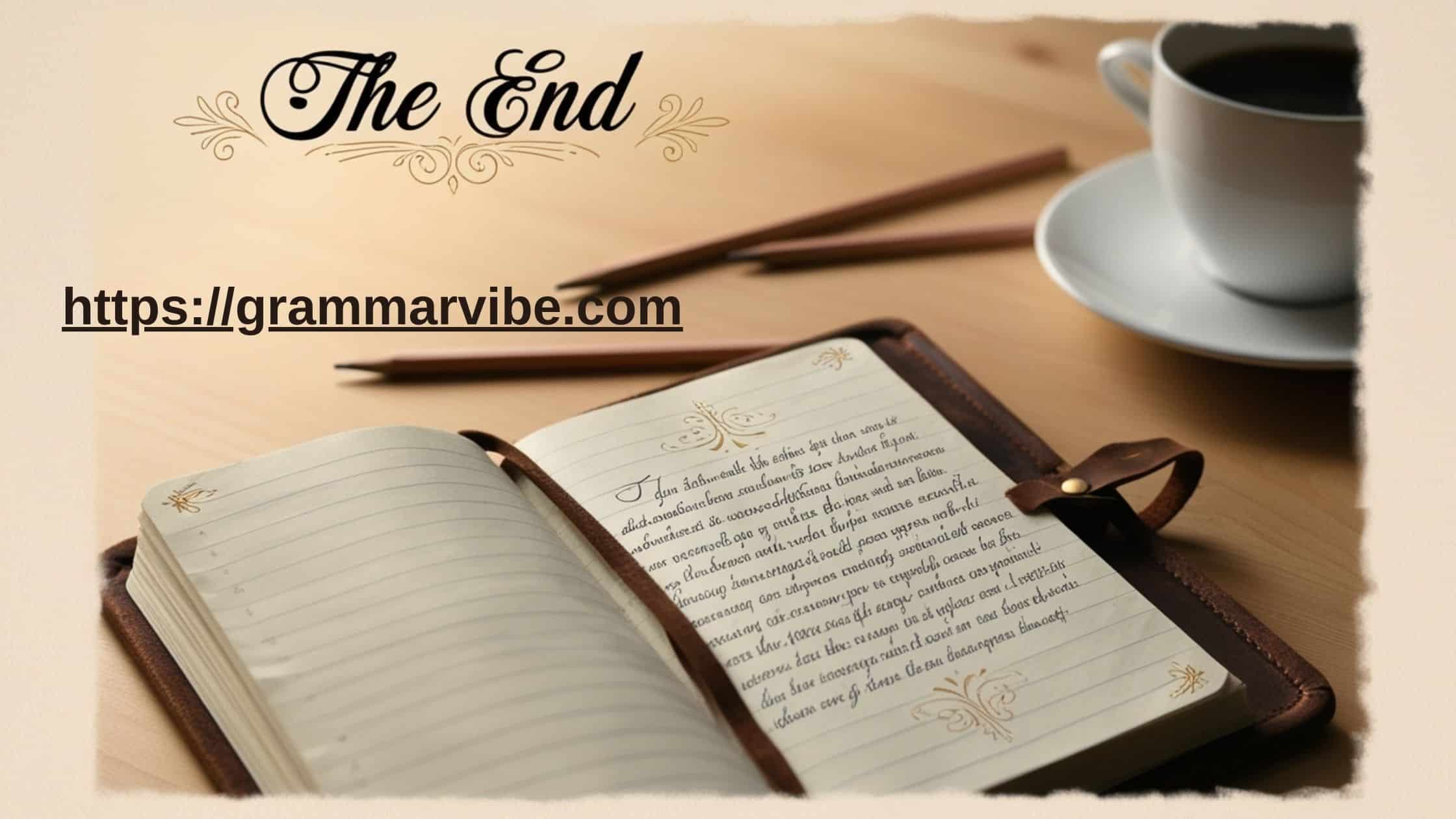The conclusion of a story is just as important as its beginning. It’s the moment when all the conflicts are resolved, the characters’ arcs come to a close, and the narrative reaches its final point. While “The End” is the simplest and most commonly used phrase, many alternative expressions can bring a unique flavor or perspective to the finish of a story. These alternatives can be formal, dramatic, reflective, or casual, depending on the tone and content of the narrative.
Let’s explore 15 alternative ways to say “The End” in a story, and how each can bring a different vibe to your closing.
1. The Conclusion
“The conclusion” is a formal and often academic term that refers to the final part of a story or argument, where all loose ends are tied up. It signals the end of the narrative while giving the audience a sense of closure, summarizing the journey the characters have taken and resolving any outstanding issues. It’s a fitting choice for reflective or structured stories.
Example in a Letter:
Hi Michael,
As we come to the conclusion of this quarter’s goals, I’m pleased to say we’ve met all of our targets. Our team’s efforts really paid off, and I look forward to our next steps.
Best regards,
Sarah
In storytelling, “the conclusion” marks the final moments when everything falls into place, and the reader has all the answers to their questions.
2. The Finale
“The finale” implies a dramatic finish, typically used when there’s a buildup to a powerful or emotional climax. It’s frequently used in movies, plays, and performances. This term emphasizes that the story or event is coming to a significant conclusion.
Example in a Novel:
The finale of the story was nothing short of extraordinary. All the characters came together, and after so much tension, the final resolution was nothing like the readers expected.
In this context, “the finale” delivers an emotional punch, often used for grand conclusions where everything reaches a powerful climax.
3. The Close
“The close” can be a more subdued way to mark the end. It suggests a natural ending, the wrapping up of all events and the final thoughts of the story. It’s less dramatic than the “finale,” but still effectively closes the narrative.
Example in an Email:
Hi Linda,
I wanted to say a huge thank you for your contributions. As we near the close of the project, it’s clear that your insights have helped bring everything together.
Best,
Tom
This term can work well in both formal and informal contexts, especially when you’re summarizing or reflecting on a complete journey.
4. The Resolution

“The resolution” refers to the point at which all conflicts and tensions in the story are resolved. It’s the part of the narrative where the protagonist’s struggles come to an end, offering a sense of closure and satisfaction.
Example in a Novel:
In the resolution of the mystery, the detective finally unmasked the villain, tying up all loose ends and bringing a sense of satisfaction to the reader.
It’s perfect for stories that involve problem-solving or conflict resolution, offering a clear and concise conclusion that brings peace to the plot.
5. The Denouement
The denouement (a French word) refers to the final stage in the story where everything is unraveled and clarified. It follows the climax and explains the final consequences of the story’s events. It is often used in literary or complex narratives, where readers expect an explanation of motives and outcomes.
Example in a Short Story:
The denouement revealed that the hero’s actions had been part of a larger plan all along, reshaping everything the reader had assumed until then.
In this case, the denouement is used to give depth to the plot and offer a satisfying conclusion to the reader.
More for you: 15 Other Ways to Say “Nice to E-Meet You”
6. The Finish
“The finish” is a more casual and direct way of indicating the end of something. It emphasizes that the story has reached its final point, often with a sense of completion or conclusion.
Example in a Film:
The finish of the movie left audiences breathless, as the final showdown between the hero and villain was more intense than anyone expected.
This term is often used for more straightforward stories where the emphasis is on finality rather than reflection or emotional resonance.
7. The Climax
The climax is the highest point of tension or excitement in a story, typically just before the resolution. It isn’t technically the “end” of the story, but it’s often the turning point that sets up the final events. The climax is often followed by the resolution, which brings closure to the story.
Example in a Novel:
The climax of the story came when the protagonist faced their greatest fear. The final decision they made changed everything in the blink of an eye.
The climax is the peak of action, and while it leads into the ending, it’s a powerful moment in itself.
For your interest: 15 Other Ways to Say “I Look Forward to Speaking With You”
8. The Curtain Call
A term borrowed from the theater, the “curtain call” happens after a performance when actors return to the stage to receive applause from the audience. In a story, it can be a metaphor for acknowledging the conclusion or giving the characters their final moment of recognition.
Example in a Play:
At the curtain call, the actors took their bows, and the audience cheered for what had been a spectacular performance.
This is often used to highlight the final recognition or gratitude for the characters after their journey is complete.
9. The Wrap-Up
“The wrap-up” suggests a quick and informal conclusion. It’s often used when summarizing or concluding a discussion or event in a straightforward manner. In storytelling, it can be used for a no-frills, matter-of-fact ending that provides closure without unnecessary detail.
Example in an Email:
Hi Mark,
As we approach the wrap-up of the project, I think we’ve made excellent progress. We just need to finish the final touches and we’re done.
Best,
Rachel
This works when you want to signal the final stages of the story with minimal fuss.
10. The Epilogue
An epilogue is a section at the end of a book, movie, or play that gives the audience additional insight into the future of the characters or the aftermath of the story’s events. It’s perfect for offering a glimpse of what’s to come or for providing final reflections on the themes of the story.
Example in a Novel:
The epilogue showed the protagonist living a quiet life years after the events of the story. The scars of their past remained, but they had found peace at last.
It’s ideal for stories that leave room for reflection or further development of the characters.
You might also like: 15 Other Ways to Say “How Is Your Day Going?”
11. The Final Act
In dramatic contexts like theater or film, “the final act” refers to the last portion of the performance or story, often involving intense action or resolution. It marks the culmination of the plot, where the central conflict reaches its highest point before resolution.
Example in a Play:
In the final act, the character’s true motives were revealed, and the audience was left stunned by the shocking revelations.
It adds a dramatic flair and signals that the story is coming to a decisive conclusion.
12. The Aftermath

“The aftermath” refers to the period after the main events of the story have concluded, often used to focus on the consequences or impact of those events.
Example in a Film:
The aftermath of the battle showed the characters rebuilding their lives, confronting the emotional and physical scars left by the conflict.
This term is used when you want to focus on the long-term effects of the story’s events rather than just the conclusion.
13. The Final Chapter
“The final chapter” can be used to indicate the last part of a narrative, where everything is wrapped up. It symbolizes the conclusion of a story, often accompanied by reflection or a sense of finality.
Example in a Novel:
The final chapter was bittersweet, as the protagonist finally accepted their fate and came to terms with the losses they had endured.
This term works well when you want to make the ending feel definitive and meaningful.
14. The Closing Remarks
This term is often used when summarizing a conversation or story. It’s especially appropriate in a non-fiction context but can be used in storytelling to bring things to a close.
Example in an Email:
Hi Clara,
As we reach the closing remarks on this project, I’d like to reiterate how impressed I am with your dedication. Let’s keep pushing to ensure we finish strong.
Best,
Eric
It’s ideal when you want to bring closure to a discussion or reflection.
Check out this: 15 Other Ways to Say “I Agree with You” Formally
15. The Final Reflection
“The final reflection” is a term that suggests a moment of introspection at the end of the narrative. It’s used when the characters (or the narrator) reflect on the lessons learned, the journey, or the changes that have occurred.
Example in a Memoir:
In her final reflection, the author expressed gratitude for the hardships she had overcome and the strength they had given her to move forward.
It’s an excellent choice for stories that involve personal growth or self-discovery.
Table: 15 Alternative Ways to Say “The End”
| Alternative Phrase | Context/Example |
|---|---|
| The Conclusion | Used for formal, reflective summaries. |
| The Finale | Common in dramatic, emotional conclusions. |
| The Close | A simple, understated end. |
| The Resolution | Focuses on the conflict resolution of the story. |
| The Denouement | Ideal for unraveling the narrative and tying up loose ends. |
| The Finish | A direct, no-nonsense end. |
| The Climax | The peak moment, often just before the end. |
| The Curtain Call | Reflects a final acknowledgment of the characters or event. |
| The Wrap-Up | A casual, informal summary of events. |
| The Epilogue | Offers future insight or final reflections on the story. |
| The Final Act | A dramatic, intense concluding portion of the plot. |
| The Aftermath | Focuses on the consequences after the conclusion. |
| The Final Chapter | Denotes the last part of the narrative. |
| The Closing Remarks | A summary or reflection used to end the story. |
| The Final Reflection | A moment of introspection or summary at the end of the story. |
Conclusion
By using these 15 phrases, you can elevate the way you end your stories, making them more memorable and impactful. Whether you choose the emotional weight of “the finale,” the formal resolution, or the reflective epilogue, each phrase offers a unique flavor to the conclusion of your narrative. As with any part of storytelling, it’s important to choose an ending that fits the tone, structure, and **journey of
your characters**. Whether you’re writing a novel, film, email, or any other type of narrative, these alternatives will ensure that your story closure feels satisfying and complete.

Kyren Paul is an experienced blogger and the creative mind behind “Grammar Vibe.” With a passion for the nuances of English grammar, he brings clarity and insight to everyday language topics, making grammar accessible and engaging for readers of all levels.











Leave a Comment